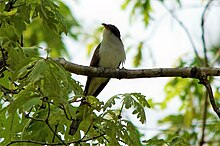
The yellow-billed cuckoo (Coccyzus americanus) is a member of the cuckoo family. Common folk names for this bird in the southern United States are rain crow and storm crow. These likely refer to the bird's habit of calling on hot days, often presaging rain or thunderstorms. The genus name is from the Ancient Greek kokkuzo, which means to call like a common cuckoo, and americanus means "of America".
Taxonomy
The yellow-billed cuckoo was formally described by the Swedish naturalist Carl Linnaeus in 1758 in the tenth edition of his Systema Naturae. He placed it with all the other cuckoos in the genus Cuculus and coined the binomial name Cuculus americanus.[2] Linnaeus based his description on the "Cuckow of Carolina" that had been described and illustrated in 1729-1732 by the English naturalist Mark Catesby in his The Natural History of Carolina, Florida and the Bahama Islands.[3] The yellow-billed cuckoo is now placed with 12 other species in the genus Coccyzus that was introduced in 1816 by the French ornithologist Louis Pierre Vieillot.[4][5] The genus name is from the Ancient Greek kokkuzō meaning "to cry cuckoo".[6] The species is monotypic: no subspecies are recognised.[5]
Description

Adults have a long tail, brown above and black-and-white below, and a black curved bill with yellow especially on the lower mandible. The head and upper parts are brown and the underparts are white. There is a yellow ring around the eye. It shows cinnamon on the wings in flight. Juveniles are similar, but the black on the undertail is replaced by gray.
Measurements:[7]
- Length: 10.2-11.8 in (26-30 cm)
- Weight: 1.9-2.3 oz (55-65 g)
- Wingspan: 15.0-16.9 in (38-43 cm)
Distribution and habitat
Their breeding habitat is deciduous woods from southern Canada to Mexico and the Caribbean. They migrate to Central America and as far south as northern Argentina. This bird is a rare vagrant in western Europe.
Behavior and ecology
Food and feeding
These birds forage in dense shrubs and trees and also may catch insects in flight. They mainly eat insects, especially tent caterpillars and cicadas, but also some lizards, eggs of other birds, and berries. Cuckoos sometimes congregate near insect outbreaks or emergences, including outbreaks of exotic gypsy moth caterpillars.[8]
Breeding
They nest in a tree or shrub, usually up to 2–12 feet (1–4 meters) above the ground. The nest is a flimsy platform of short twigs placed on a horizontal branch. The 3–4 eggs are incubated for 14 days or less. The chicks are able to climb about with agility at 7–9 days of age. At about this same time, the feathers of the chicks burst out of their sheaths and the young are able to fly. The entire time from egg-laying to fledging may be as little as 17 days. Yellow-billed cuckoos occasionally lay eggs in the nests of other birds (most often the closely related black-billed cuckoo), but they are not obligate brood parasites of other birds as is the common cuckoo of Eurasia.

Conservation status
There is an ongoing debate regarding the taxonomic status of the Western race and whether it is distinct from those birds in the east. This question is significant to the conservation status of this species in the west, where it has declined to a tiny fraction of its population a century ago.[9][10][11] Populations of this species in western North America are in steep decline. The bird disappeared from British Columbia, Washington, and Oregon during the first half of the twentieth century. Eastern populations have declined as well, though not as precipitously. The United States Fish and Wildlife Service listed the western Distinct Population Segment (DPS) of Yellow-billed Cuckoos as threatened under the Endangered Species Act on 11/3/2014,[12] and the service also has established 546,335 acres in nine western states as critical habitat for the western DPS of the yellow-billed cuckoo.[13][14] Controversy over the taxonomic status and heavy pressure from livestock and mining industries caused the Trump administration to attempt to end the species' protections, and the FWS reviewed the bird's listing.[15] In September 2020, the USFWS determined that the western DPS of yellow-billed cuckoo is distinct, and the listing as Threatened is warranted.[16]
References
- ^ BirdLife International (2016). "Coccyzus americanus". IUCN Red List of Threatened Species. 2016: e.T22684331A93025386. doi:10.2305/IUCN.UK.2016-3.RLTS.T22684331A93025386.en. Retrieved 11 November 2021.
- ^ Linnaeus, Carl (1758). Systema Naturae per regna tria naturae, secundum classes, ordines, genera, species, cum characteribus, differentiis, synonymis, locis (in Latin). Vol. 1 (10th ed.). Holmiae (Stockholm): Laurentii Salvii. p. 111.
- ^ Catesby, Mark (1729–1732). The Natural History of Carolina, Florida and the Bahama Islands (in English and French). Vol. 1. London: W. Innys and R. Manby. p. 9, Plate 9.
- ^ Vieillot, Louis Pierre (1816). Analyse d'une Nouvelle Ornithologie Élémentaire (in French). Paris: Deterville/self. p. 28.
- ^ a b Gill, Frank; Donsker, David; Rasmussen, Pamela, eds. (January 2022). "Turacos, bustards, cuckoos, mesites, sandgrouse". IOC World Bird List Version 12.1. International Ornithologists' Union. Retrieved 13 August 2022.
- ^ Jobling, James A. (2010). The Helm Dictionary of Scientific Bird Names. London: Christopher Helm. p. 112. ISBN 978-1-4081-2501-4.
- ^ "Yellow-billed Cuckoo Identification, All About Birds, Cornell Lab of Ornithology". Allaboutbirds.org. Retrieved 26 September 2020.
- ^ Barber, NA; Marquis, RJ; Tori, WP (2008). "Invasive prey impacts the abundance and distribution of native predators". Ecology. 89 (10): 2678–2683. Bibcode:2008Ecol...89.2678B. doi:10.1890/08-0395.1. PMID 18959305.
- ^ "Yellow-Billed Cuckoo Species Account, Sacramento Fish & Wildlife Office". Fws.gov. Retrieved 15 March 2022.
- ^ "Biogeography of Western Yellow Billed Cuckoo". Bss.sfsu.edu. Retrieved 15 March 2022.
- ^ Fleischer, Robert C. "Taxonomic and Evolutionarily Significant Unit (ESU) Status of Western Yellow-billed Cuckoos (Coccyzus americanus)". Report to the USGS and USFWS.
- ^ "ECOS: Species Profile". Ecos.fws.gov. Retrieved 15 March 2022.
- ^ "Proposed Rules : Endangered and Threatened Wildlife and Plants; Revised Designation of Critical Habitat for the Western Distinct Population Segment of the Yellow Billed Cuckoo" (PDF). Federal Register. 85 (39). 27 February 2020. Retrieved 15 March 2022.
- ^ "Endangered and Threatened Wildlife and Plants; Designation of Critical Habitat for the Western Distinct Population Segment of the Yellow-Billed Cuckoo (Coccyzus americanus)". Federal Register. 2 December 2014. Retrieved 29 June 2018.
- ^ "Trump Administration Moves to Strip Endangered Species Protections From Threatened Western Songbird". Biologicaldiversity.org. Retrieved 29 June 2018.
- ^ "Proposed Rules : Endangered and Threatened Wildlife and Plants; Findings on a Petition To Delist the Distinct Population Segment of the Western Yellow-Billed Cuckoo" (PDF). Federal Register. 85 (180). 16 September 2020. Retrieved 15 March 2022.
Further reading
- John K. Terres (1980), Audubon Society Encyclopedia of North American Birds, Knopf, ISBN 0-394-46651-9
- David Gaines Review of the Status of the Yellow-Billed Cuckoo in California: Sacramento Valley Populations The Condor, Vol. 76, No. 2 (Summer, 1974), pp. 204–209
- Laymon, S.A., and M.D. Halterman. 1987. Can the western subspecies of Yellow-billed Cuckoo be saved from extinction? Western Birds 18:19-25.
External links
|
Help
|
|
Browse
|
Search
|
Create the page "Yellow-billed cuckoo" on this wiki!
- James Audubon|John James Audubon]] depicting Yellow-billed Cuckoo. |Source=*[[:File:2_Yellow-billed_Cuckoo.jpg|]] |Date=20 Uploaded with derivativeFX English...(1,327 × 1,051 (535 KB)) - 13:41, 28 December 2020
- Yellow billed cuckoo (Coccyzus americanus) Photo by J. A. Spendelow...(288 × 510 (40 KB)) - 23:52, 8 December 2014
- English Yellow-billed Cuckoo determination method: SHA-1...(4,075 × 3,023 (7.55 MB)) - 19:40, 23 March 2024
- description page was here. All following user names refer to en.wikipedia. 2003-10-23 10:23 Big iron 250×170× (5848 bytes) Yellow-billed cuckoo from USNPS...(250 × 170 (6 KB)) - 23:01, 28 October 2013
- the 2006-2007 yellow-billed cuckoo project ( ) Author Halterman, Murrelet Title Final report for the 2006-2007 yellow-billed cuckoo project Publisher...(1,681 × 2,206 (10.64 MB)) - 00:54, 21 July 2020
- Coccyzus americanus Vernacular names [edit wikidata 'Yellow-billed Cuckoo'] English: Yellow-billed Cuckoo العربية: وقواق أصفر المنقار مصرى: وقواق اصفر المنقار...1 KB (255 words) - 08:45, 17 November 2023
- Breeding status of the yellow-billed cuckoo in the South Fork Kern River Valley, Kern County, California : summary report 1985-1996 ( ) Title Breeding...(1,687 × 2,191 (10.88 MB)) - 02:53, 19 December 2023
- DescriptionYellow-billed Cuckoo, Barnegat, New Jersey.jpg English: Barnegat NJ Date 16 May 2021 Source Own work Author Rogerljr...(1,914 × 1,272 (1.41 MB)) - 06:54, 10 April 2022
- DescriptionYellow-billed Cuckoo, Pennsylvania (29761200921).jpg Because it's all you get Date 21 September 2016, 18:12 Source I hope you like cuckoos Author...(2,930 × 2,205 (2.61 MB)) - 11:25, 23 May 2024
- DescriptionYellow-billed cuckoo (50626792726).jpg Yellow-billed cuckoo Date 23 September 2020, 14:04 Source Yellow-billed cuckoo Author Melissa McMasters...(5,760 × 3,840 (1.58 MB)) - 08:20, 11 July 2023
- DescriptionYellow-billed cuckoo (40917329963).jpg Yellow-billed cuckoo Date 17 May 2019, 16:23 Source Yellow-billed cuckoo Author Melissa McMasters from...(5,760 × 3,840 (1.62 MB)) - 16:44, 16 April 2023
- DescriptionYellow-billed Cuckoo (34996516076).jpg Yellow-billed Cuckoo Date 29 May 2017, 16:25 Source Yellow-billed Cuckoo Author Andy Reago & Chrissy...(3,301 × 2,331 (2.34 MB)) - 21:42, 16 October 2020
- DescriptionYellow-billed cuckoo (33972726043).jpg Yellow-billed cuckoo Date 15 May 2017, 15:21 Source Yellow-billed cuckoo Author Melissa McMasters from...(5,760 × 3,840 (2.08 MB)) - 17:17, 26 March 2022
- DescriptionYellow-billed Cuckoo (34872543002).jpg Yellow-billed Cuckoo Date 29 May 2017, 16:25 Source Yellow-billed Cuckoo Author Andy Reago & Chrissy...(3,397 × 2,475 (2.52 MB)) - 13:47, 20 May 2024
- DescriptionYellow-billed cuckoo (20879806938).jpg Yellow-billed cuckoo Date 31 August 2015, 10:36 Source Yellow-billed cuckoo Author Melissa McMasters...(3,005 × 2,003 (640 KB)) - 03:48, 4 October 2020
- DescriptionYellow-billed cuckoo.jpg English: At Horseshoe Lake State Park, Pontoon Beach, Illinois Date 7 August 2021, 15:32:11 Source https://www.flickr...(4,128 × 2,752 (1.23 MB)) - 07:51, 7 July 2024
- DescriptionYellow-billed Cuckoo (34226080373).jpg Yellow-billed Cuckoo Date 29 May 2017, 16:25 Source Yellow-billed Cuckoo Author Andy Reago & Chrissy...(3,400 × 2,602 (2.7 MB)) - 21:42, 16 October 2020
- DescriptionYellow-billed cuckoo (46967700885).jpg Yellow-billed cuckoo Date 17 May 2019, 16:23 Source Yellow-billed cuckoo Author Melissa McMasters from...(3,853 × 2,569 (844 KB)) - 16:44, 16 April 2023
- DescriptionYellow-billed Cuckoo (34974957806).jpg Yellow-billed Cuckoo Date 26 May 2017, 13:47 Source Yellow-billed Cuckoo Author Andy Reago & Chrissy...(4,570 × 3,561 (4.13 MB)) - 15:10, 12 May 2024
- DescriptionYellow-billed cuckoo (50626792991).jpg Yellow-billed cuckoo Date 23 September 2020, 14:01 Source Yellow-billed cuckoo Author Melissa McMasters...(5,760 × 3,840 (2.27 MB)) - 08:20, 11 July 2023


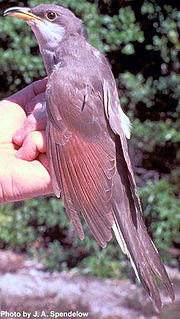
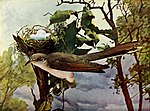
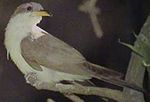
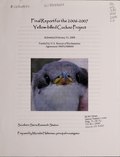
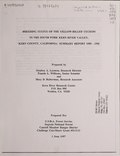





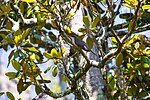
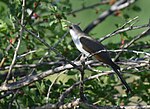



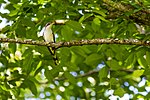

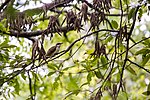
Recent Comments